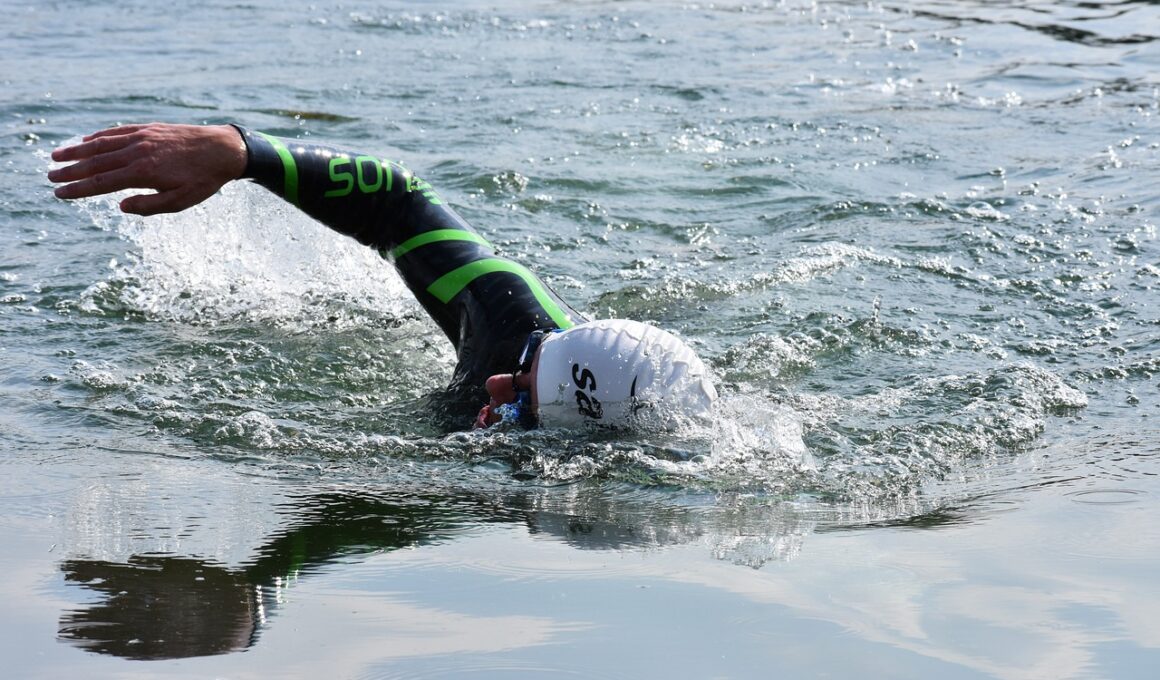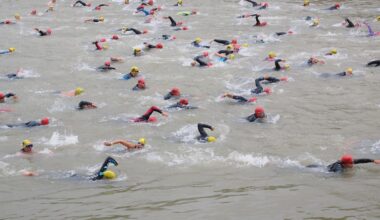Training in Different Elevations for Olympic Distance Races
Triathlon training at different elevations presents unique challenges and opportunities, especially for Olympic distance races. One key benefit of training at higher altitudes is improved oxygen efficiency. When athletes train in environments where oxygen levels are lower, their bodies adapt by producing more red blood cells, enhancing their aerobic capacity and endurance. However, this adaptation can take time, and it is important for athletes to approach altitude training cautiously. Understanding how to properly acclimatize is crucial for reaping the benefits without suffering from altitude sickness. Training under high skies can also invigorate mental resilience, providing a fresh perspective on training routines. Furthermore, athletes can hone their pacing strategies while adjusting to oxygen-depleted environments. While it might feel daunting at first, consistently training at higher altitudes is likely to translate into improved performance during races held at sea level. Consequently, many triathletes strategically look for race preparation locations that feature elevated terrains. Such locations often include trails, mountains, and the like, which not only prepare their bodies but also engage their sense of adventure and exploration.
Adaptation to varying elevations is critical for Olympic distance triathlon success. Training at sea level following a period of altitude training can help athletes benefit from their increased fitness. This phenomenon is often referred to as the ‘live high, train low’ method. By living at a high altitude, the body adapts to lower oxygen levels, but training sessions are performed at sea level to enable high-intensity workouts. Athletes should schedule their training program to balance the benefits of both environments effectively. When transitioning back to sea level after an altitude training block, athletes can experience enhanced performance due to greater VO2 max levels. It’s imperative to design workouts that leverage this heightened fitness. Intervals, tempo runs, and long climbs can be structured to allow the athlete to push boundaries. Recovery is equally important during these transitions; athletes must listen to their bodies and avoid over-exertion. Nutrition also plays a significant role in maximizing benefits during these training cycles. Hydration and fuel must be adequate to support the increased workload. With smart training, athletes can optimize their performance for Olympic distance triathlons.
The Importance of Acclimatization
Acclimatization is a crucial step when training at various elevations for Olympic distance triathlons. When athletes ascend to higher altitudes, their bodies require time to adjust to the lower oxygen availability. This adjustment period can vary from individual to individual, but typically ranges from a few days to several weeks, depending on the elevation. During this time, athletes may experience symptoms such as increased heart rate, fatigue, or even lack of appetite. Gradually exposing the body to higher altitudes helps in reducing these symptoms and enhances oxygen transport capabilities within the blood. Athletes can combine endurance training with sessions focused on strength to bolster their acclimatization process. Moreover, understanding the unique stressors of high-altitude training permits athletes to create personalized training strategies rather than following one-size-fits-all recommendations. Our perception of effort might shift in high altitude, therefore conducting training at different intensities becomes essential for preparing for races. Evaluating performance consistently allows athletes to track their adaptations, ensuring that they can gauge improvements effectively. The benefit is not only physical adaptation but also psychological fortitude built through overcoming elevation challenges.
Nutrition is paramount when embarking on high-altitude training cycles. At increased elevations, the body’s caloric needs change due to heightened energy expenditures and faster dehydration rates. Prioritizing carbohydrate intake can enhance performance and stamina, particularly when preparing for intense workouts. It’s wise to incorporate foods rich in complex carbohydrates, lean proteins, and healthy fats. Consuming larger meal portions, along with frequent snacks, ensures that energy levels remain stabilized during long training sessions. Hydration should also be heightened, especially at higher elevations where the dry air can lead to increased fluid loss. Electrolyte balance is essential; athletes should consider electrolyte-rich beverages to counteract the losses that occur during rigorous activity. Furthermore, incorporating iron-rich foods can further assist with oxygen transport and help mitigate the risks of altitude sickness. Foods such as spinach, beans, and red meat can be beneficial to maintaining optimal iron levels. Supplements can play a role too, especially for those with specific dietary restrictions or concerns. Staying vigilant about nutritional needs will aid in maximizing the adaptations garnered through altitude training, enhancing overall performance in Olympic distance races.
Training Regimens at Varying Altitudes
In developing effective training regimens for Olympic distance triathlons, athletes must consider the elevation variations they will experience during their workouts. When training at high altitudes, incorporating specific endurance and interval workouts can optimize physiological adaptations. Longer aerobic sessions are essential to build a solid endurance base. However, the intensity of workouts must be carefully monitored. Strength training can also take on a new significance, with resistance exercises focusing on building muscle to counterbalance the difficulties posed by lower oxygen availability. Additionally, interval training should be adjusted, emphasizing shorter, high-intensity bursts to exploit the body’s adaptation to lower oxygen levels while promoting fast-twitch muscle fibers development. It’s important to integrate recovery sessions, allowing the body to recover properly between peak workouts. Including both aerobic and anaerobic training is vital—each serves unique purposes in enhancing performance. Communication with coaches and trainers can help ensure that the regimen is both comprehensive and sustainable. Finally, athletes should remain adaptable, willing to modify their training plans based on their progression and how well they are responding to the elevation.
Preparing for Olympic distance triathlons at varying elevations also encourages discipline and flexibility. High-elevation training may mean outdoor conditions can change quickly, and athletes must incorporate this variability into their plans. Training indoors or on simulators can serve as an excellent alternative when outdoor conditions are less than ideal. Indoor training can also allow for carefully controlled environments where heart rate and exertion levels can be monitored closely. The key to success is balancing periods of hard work followed by adequate recovery, as elevation can be taxing. Regularly scheduled evaluations ensure that athletes can adjust their training approaches in line with their ongoing experiences and fitness level. Creating benchmarks for performance can help identify strengths to capitalize on and weaknesses to strengthen, ultimately refining overall fitness. Furthermore, establishing a support network, whether through training partners or local clubs, can greatly enhance motivation and accountability. As training progresses, reflecting on personal growth and achievements will provide encouragement, especially when faced with the pressures of competition. This balance of structure and flexibility proves beneficial for Olympic distance triathletes preparing for races at various elevations.
Race Day Strategy
On race day, athletes must implement a strategy that embraces their high-altitude training while addressing the potential challenges that may arise during the event. Knowing how to pace oneself is crucial; transitioning from higher altitude training to race-day conditions showcases the importance of maintaining appropriate speed without exhausting oneself early. Understanding hydration needs and establishing a nutrition plan that complements race dynamics will enhance performance. Athletes should ensure that they consume sufficient fluids before and during the race, as conditions at elevation can often lead to quicker dehydration. Monitoring the race course for elevation changes will also assist in gauging effort, as certain segments may demand more output than others. Focusing on breathing techniques can help manage exertion levels during challenging sections, especially at the onset of the bike segment where oxygen demands spike. Additionally, mental preparation, reinforced through rigorous and diverse training conditions, becomes a crucial tool in a triathlete’s arsenal. Visualization techniques can also bolster confidence as race day approaches. Ultimately, athletes who incorporate lessons from high-elevation training effectively can leverage their unique advantages, maximizing their potential for success.
In conclusion, training at varied elevations for Olympic distance triathlons offers numerous advantages when approached with effective strategies. From the physiological adaptations of higher altitudes to the structured regimens that hone athletic capability, each aspect is essential in preparing for vitality during competition. As athletes navigate the challenges of elevation differences, acclimatization becomes foundational. By prioritizing nutrition, hydration, and methodical training plans, they can fully prepare for race day. Mental resilience, built through these elevation experiences, complements the physical fitness gained, creating well-rounded triathletes ready for competition. The adaptability in training regimens is vital for maximizing the benefits achieved through altitude exposure, ultimately enriching the competitive experience on race day. Embracing the uncertainties of elevation training ensures that athletes emerge stronger and more determined. Commitment to their aims can lead to remarkable outcomes in performance. Through strategic planning and execution, triathletes significantly enhance their likelihood of success during Olympic distance races. Consideration of elevation as a factor in training also allows for deeper exploration and connection with the sport while fostering community among fellow competitors in that journey.


